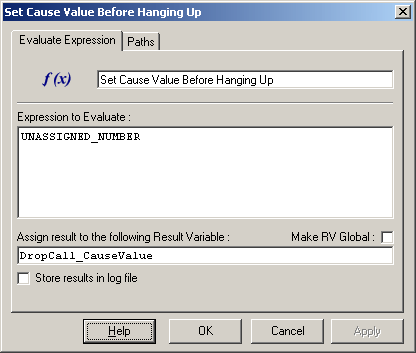 Hangup the Call
Hangup the Call
Hangs up the current call.
On ISDN systems the 'Cause Value' which is sent at the time of call disconnection can be specified by setting the $RV[DropCall_CauseValue]
Evaluate Expression module can be used to assign a cause value to $RV[DropCall_CauseValue] :

Possible cause values are:
Cause Value Tag | Cause Value Sent |
| UNASSIGNED_NUMBER | hex: 01 - Cause 01 |
| NO_ROUTE | hex: 02 - Cause 02 |
| NO_ROUTE_TO_DEST | hex: 03 - Cause 03 |
| SEND_SPECIAL_ITONE | hex: 04 - Cause 04 |
| MISDIALLED_TRUNK_PFX | hex: 05 - Cause 05 |
| CHANNEL_UNACCEPTABLE | hex: 06 - Cause 06 |
| CALL_AWARDED_IN_EST_CHAN | hex: 07 - Cause 07 |
| PREEMPTION | hex: 08 - Cause 08 |
| PREEMPTION_CHAN_RESERVED | hex: 09 - Cause 09 |
| QOR_PORTED_NUMBER | hex: 0E - Cause 14 |
| NORMAL_CLEARING | hex: 10 - Cause 16 |
| USER_BUSY | hex: 11 - Cause 17 |
| NO_USER_RESPONDING | hex: 12 - Cause 18 |
| NO_ANSWER_FROM_USER | hex: 13 - Cause 19 |
| SUBSCRIBER_ABSENT | hex: 14 - Cause 20 |
| CALL_REJECTED | hex: 15 - Cause 21 |
| NUMBER_CHANGED | hex: 16 - Cause 22 |
| REDIR_NEW_DESTINATION | hex: 17 - Cause 23 |
| REJECTED_FEATURE_DEST | hex: 18 - Cause 24 |
| EXCHANGE_ROUTING_ERR | hex: 19 - Cause 25 |
| NON_SELECTED_USR_CLEAR | hex: 1A - Cause 26 |
| DEST_OUT_OF_ORDER | hex: 1B - Cause 27 |
| INVALID_NUMBER_FORMAT | hex: 1C - Cause 28 |
| FACILITY_REJECTED | hex: 1D - Cause 29 |
| RESP_TO_STAT_ENQ | hex: 1E - Cause 30 |
| UNSPECIFIED_CAUSE | hex: 1F - Cause 31 |
| NO_CIRCUIT_AVAILABLE | hex: 22 - Cause 34 |
| NETWORK_OUT_OF_ORDER | hex: 26 - Cause 38 |
| PFM_CONN_OUT_OF_SERVICE | hex: 27 - Cause 39 |
| PFM_CONN_OPERATIONAL | hex: 28 - Cause 40 |
| TEMPORARY_FAILURE | hex: 29 - Cause 41 |
| NETWORK_CONGESTION | hex: 2A - Cause 42 |
| ACCESS_INFO_DISCARDED | hex: 2B - Cause 43 |
| REQ_CHANNEL_NOT_AVAIL | hex: 2C - Cause 44 |
| PRE_EMPTED | hex: 2D - Cause 45 |
| CALL_BLOCKED | hex: 2E - Cause 46 |
| RESOURCE_UNAVAILABLE | hex: 2F - Cause 47 |
| QOS_UNAVAILABLE | hex: 31 - Cause 49 |
| FACILITY_NOT_SUBSCRIBED | hex: 32 - Cause 50 |
| BEARER_INCOMPAT_SERVICE | hex: 33 - Cause 51 |
| OUTGOING_CALL_BARRED | hex: 34 - Cause 52 |
| OUTGOING_BARRED_IN_CUG | hex: 37 - Cause 53 |
| INCOMING_CALL_BARRED | hex: 36 - Cause 54 |
| INCOMING_BARRED_IN_CUG | hex: 37 - Cause 55 |
| BEAR_CAP_NOT_AUTHL | hex: 39 - Cause 57 |
| BEAR_CAP_NOT_AVAIL | hex: 3A - Cause 58 |
| INCONSISTANT_OUTB_INFO | hex: 3E - Cause 62 |
| SERVICE_NOT_AVAIL | hex: 3F - Cause 63 |
| CAP_NOT_IMPLEMENTED | hex: 41 - Cause 65 |
| CHAN_NOT_IMPLEMENTED | hex: 42 - Cause 66 |
| FACILITY_NOT_IMPLEMENT | hex: 45 - Cause 69 |
| RESTRICTED_DIG_INFO_ONLY | hex: 46 - Cause 70 |
| SERVICE_NOT_IMPLEMENTED | hex: 4F - Cause 79 |
| INVALID_CALL_REF | hex: 51 - Cause 81 |
| CHAN_DOES_NOT_EXIST | hex: 52 - Cause 82 |
| BAD_CALL_ID_FOR_SUS_CALL | hex: 53 - Cause 83 |
| CALL_ID_NOT_IN_USE | hex: 54 - Cause 84 |
| NO_SUSPENDED_CALL | hex: 55 - Cause 85 |
| CALL_ID_CLEARED | hex: 56 - Cause 86 |
| NOT_MEMBER_OF_CUG | hex: 57 - Cause 87 |
| INCOMPATIBLE_DEST | hex: 58 - Cause 88 |
| NONEXISTENT_CUG | hex: 5A - Cause 90 |
| INVALID_TRANS_NETWORK | hex: 5B - Cause 91 |
| INVALID_MSG_UNSPEC | hex: 5F - Cause 95 |
| MANDATORY_IE_MISSING | hex: 60 - Cause 96 |
| NONEXISTENT_MSG | hex: 61 - Cause 97 |
| WRONG_MESSAGE | hex: 62 - Cause 98 |
| BAD_INFO_ELEM | hex: 63 - Cause 99 |
| INVALID_ELEM_CONTENTS | hex: 64 - Cause 100 |
| WRONG_MSG_FOR_STATE | hex: 65 - Cause 101 |
| TIMER_EXPIRY | hex: 66 - Cause 102 |
| MANDATORY_IE_LEN_ERR | hex: 67 - Cause 103 |
| MSG_W_UNRECOGNIZED_PARAM | hex: 6E - Cause 110 |
| PROTOCOL_ERROR | hex: 6F - Cause 111 |
| INTERWORKING_UNSPEC | hex: 7F - Cause 127 |
Alternatively, the decimal value itself can be assigned to the $RV[DropCall_CauseValue]
eg: Assigning 54 to $RV[DropCall_CauseValue] would have the same effect as assigning INCOMING_CALL_BARRED to $RV[DropCall_CauseValue]
This allows for other custom codes, which do not have a predefined tag, to be sent.
Definition of the various standard cause codes can be found in the ITU-T's Q.850 recommendation: http://www.itu.int/rec/T-REC-Q.850/en
ITU-T's Q.931 (ISDN) recommendation itself can be found at: http://www.itu.int/rec/T-REC-Q.931-199805-I/en